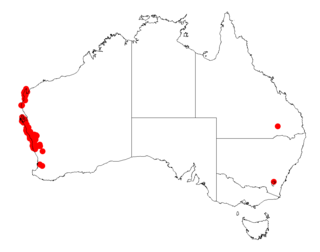
Acacia pterocaulon is a shrub belonging to the genus Acacia and subgenus Alatae. It is native to a small area in the Mid West region of Western Australia.

Acacia tetragonocarpa is a shrub belonging to the genus Acacia. It is native to the South West region of Western Australia.

Acacia elachantha is a shrub belonging to the genus Acacia and the subgenus Juliflorae. It is native to arid parts of central and northern Australia.

Acacia rhodophloia, commonly known as minni ritchi or western red mulga, is a tree or shrub belonging to the genus Acacia and the subgenus Juliflorae that is endemic to a large area of arid central western Australia. The Indigenous group the Kurrama peoples know the plant as mantaru.

Acacia yorkrakinensis is a shrub belonging to the genus Acacia and the subgenus Juliflorae that is native to Western Australia.

Acacia acanthaster is a shrub belonging to the genus Acacia and the subgenus Phyllodineae. It is native to an area in the Great Southern and Goldfields-Esperance regions of Western Australia.

Acacia argutifolia, commonly known as the East Barrens wattle, is a shrub belonging to the genus Acacia and the subgenus Phyllodineae.

Acacia chrysocephala is a shrub belonging to the genus Acacia and the subgenus Phyllodineae.

Acacia concolorans is a shrub belonging to the genus Acacia and the subgenus Phyllodineae that is endemic to Western Australia.

Acacia crassiuscula is a shrub belonging to the genus Acacia and the subgenus Phyllodineae found along the south coast of Western Australia.

Acacia dilatata is a shrub belonging to the genus Acacia and the subgenus Phyllodineae which is endemic to Western Australia.

Acacia littorea, also known as the shark tooth wattle, is a shrub belonging to the genus Acacia and the subgenus Phyllodineae.

Acacia pachyphylla is a shrub belonging to the genus Acacia and the subgenus Phyllodineae that is endemic to south western Australia.

Acacia spathulifolia commonly known as Gold carpet or the Gold carpet wattle is a shrub of the genus Acacia and the subgenus Phyllodineae that is endemic to coastal parts of western Australia.

Acacia sphenophylla is a shrub of the genus Acacia and the subgenus Phyllodineae that is endemic to a small area in western Australia.

Acacia anfractuosa is a shrub or tree of the genus Acacia and the subgenus Plurinerves that is endemic to Western Australia.

Acacia pharangites, commonly known as Wongan gully wattle, is a shrub of the genus Acacia and the subgenus Plurinerves that is endemic to a small area of south western Australia and is listed as endangered according to the Environment Protection and Biodiversity Conservation Act 1999.

Acacia roycei is a shrub or tree of the genus Acacia and the subgenus Plurinerves that is endemic to an area of western Australia.

Acacia guinetii, commonly known as Guinet's wattle, is a shrub of the genus Acacia and the subgenus Pulchellae that is endemic to a small area along the coast of western Australia

Acacia cretacea, also known as chalky wattle, is a shrub belonging to the genus Acacia and the subgenus Phyllodineae that is endemic to South Australia.




















